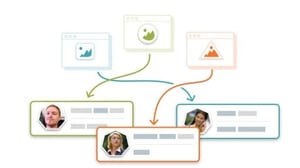 Written by Felipe Gil
Written by Felipe Gilon October 15, 2018
Today’s financial marketing strategies benefit by combining the same message across multiple channels, both traditional and digital, to connect with all its different audiences.
Not all digital channels have the same effectiveness for every customer, and having more channels can only work to our advantage. Still, why is not everyone taking advantage of the multichannel onboarding?
Do you remember when everyone used to have a landline? Answering the phone without knowing who was calling? Or when Saturday morning was for touring around the mall looking for a new dress?
Ever since smartphones appeared in our lives they slowly but steadily transformed every little thing we do.
From the way we interact with each other to the way we make purchases or even do our jobs. But there still remain some people who call and say “Hello, is Annie at home?” People who enjoy old-school shopping... But why does this feel a bit nostalgic and cumbersome? The answer is simple: because online channels, most of the time, are handy, and even more enjoyable.
They allow us to do things quickly, compare between a wider batch of products or services, be more efficient in finding some product and, in the end, online channels simply make customers happier. It’s not all that different when it comes to bank services. Whether it’s opening a savings account or getting a new credit card, customers want this process to be as easy as possible.
Is it really the same opening an account from your phone than to visit a local branch? Of course not! There are still some people who prefer a face to face experience and feel uncomfortable with the idea of doing things online. But the benefits of online channels have already proved to be so effective that more and more people turn to them looking to save time and get things solved in the best possible way.
In financial marketing, a huge emphasis is put on acquisition, but not all companies are invested in doing it right. Every customer expects easy and seamless processes, but those who regularly use a smartphone also expect this to happen at anytime and anywhere.
These users simply love apps, and financial institutions that understand the effectiveness of multichannel communications will accommodate better to these users’ expectations.
[[ Read more: A guide to run campaigns for financial services effectively ]]
Most banks know the onboarding process is crucial for establishing a relationship with a new customer, but many companies ignore just how new ways for reaching them really work. Not all digital channels have the same effectiveness for every customer, and having more channels can only work to our advantage. Still, why is not everyone taking advantage of the multichannel onboarding?
- There is a lack of understanding of the multichannel purchaser’s journey.
A customer’s life cycle begins with the acquisition but it is no longer a linear or predictable process. Digital enrollment is a great way to gain new members, but customers may want to start the process on their phone and finish it later, on their computer.
Some banks don’t maximize on their digital tools and, for example, they make their leads start an application process online and fill the same information at a branch in person. If your customers don’t have a seamless experience across mobile and web, you will most likely lose them.

- There is no follow up.
Like any other relationship, the one with your client needs nurturing so they keep choosing you. If you are losing more than half of these new customers within the first 90 days, chances are you are not getting them onboard properly.
Whether it’s to appreciate their business, helping them get set up or offering new services, a meaningful first contact is essential. As the actor Will Rogers said: “You never get a second chance to make a first impression”. So to make a good first impression, a customized welcome kit is a great way to start.
- The onboarding message didn’t arrive soon enough.
Your clients love for you to get in contact with them as quickly as possible, not only to answer questions they may have but to establish an early dialogue.
Delayed or lack of communication has a negative impact not only for retention but for cross-selling opportunities as well.
- Not every customer is the same and not all channels work the same way.
To be effective, each channel needs to be used in specific ways at specific moments of the customer’s journey. According to the Digital Banking Report, for example, social media works best for consumers in early stages of the sale process but is less effective for closing sales. Emails have about 81% of effectiveness in the later stages and are a great way to send out information, deals or alerts.
- Age is an important factor.
Millennials have almost completely abandoned physical channels, and most only engage with their banks digitally. They are the most frequent users online and are truly omnichannel customers. In another research conducted by the Digital Banking Report, about 22% of the users who are between 18 and 24 years old use their bank’s mobile app daily. Only 5% of them visit their bank’s branch.
This age group is important, they are who we want to attract to join the financial market. While people in this age group may change firms because they are not comfortable with its online channels, most people past this age group only change firms because they are unhappy with their current one, moved or had a significant life event.
- Popularity of self-serve channels.
Many customers, especially younger ones, are relying more on self-serve channels, whether it’s to set up their service or seek for professional help. The Financial Brand states that 60% of individuals still use physical branches as the primary point of contact with their bank, although it’s not always by choice.
Many banks struggle to offer multichannel contact, especially for the application process and customer care.
- Banks still don’t understand the profitably.
Gaining a new customer comes at a higher cost than retaining one. It would be a missed opportunity not to take full advantage of all these ways to communicate and satisfy customers’ needs. Making a first contact through automated messages across multiple channels will helps us identify which channel each person prefers. We can use analytics to personalize each message, establish cost-efficient communications and have better cross-selling opportunities.
About 42% of banks prioritize digital channels for more effective cross-selling, according to the Digital Banking Report, the onboarding contact is a great moment to offer additional products and services.

Customers want to be able to choose the channel that suits them best. If your competition offers a more flexible onboarding process, chances are that they will be chosen first. If we think about it in terms of doors, while you have only one door to enter the bank, your competition might be having ten, all wide open.
Today’s financial marketing strategies benefit by combining the same message across multiple channels, both traditional and digital, to connect with all its different audiences.
Appealing to different groups through different touch points can significantly improve results. In the end is just as simple as The Beatles once sung “make it easy to be near you.”
Prisma Campaigns is a smart omni-channel marketing solution for financial services especialized in customer loyalty
Do you want to know how it works and how can it help you to run effective customer onboardings?
Image credit: shutterstock.
